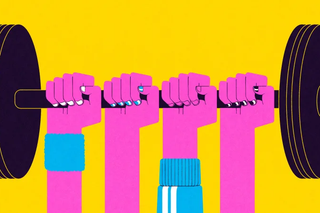
In Ultra‑Endurance Races, Women Are Quietly Leaving Men in Their Dust
Maybe it’s time to talk about how women have way more endurance, stamina than men.

In January, Jasmin Paris made history. The 35-year-old cancer researcher who works at the University of Edinburgh became the first woman to win the 268-mile Montane Spine Race, beating both her male and female competitors and smashing the previous record by more than 12 hours.
Oh, all that while also pumping breast milk for her baby daughter at aid stations along the route.
Paris is hardly alone. In 2016, Lael Wilcox became the first woman to win the 4,400-mile self-supported U.S. West-to-East Coast bike race known as the Trans Am, finishing it in 18 days, 10 minutes — the second-best course time ever, man or woman. In a single weekend in December 2016, “women runners took five outright victories in ultramarathons across the country, with 42-year-old Caroline Boller setting a new course record at the Brazos Bend 50-mile trail race in Texas,” reports Meaghen Brown, an ultra-racer herself, for Outside Online. And at several points in the last century, women have held the record for swimming the English Channel, beating male swimmers who came before.
Despite scientific predictions dating back to the early 90s that women would be able to beat men at long-distance running, science is just now starting to accept the possibility (now, actuality) and study how and why women seem able to outperform men at ultra-endurance racing — that is, anything longer than six hours.
Related on The Swaddle:
Ada Hegerberg Deserves to be Honored for Her Success in Football Without Being Undermined By Sexism
In 2004, Sandra Hunter, PhD, a professor of exercise science at Milwaukee’s Marquette University, conducted an experiment in which men and women completed the same isometric arm exercises. They were asked to perform the task until they could do it no longer. On average, women failed after performing the task for three times longer than men — 23.5 minutes to the men’s 8.5.
More recently, a similar 2017 study tested men and women in movement exercises — flexing their foot as quickly as possible for 200 flexes. While men started off with more power and speed, they tired much more quickly than women.
“We’ve known for some time that women are less fatigable than men during isometric muscle tests — static exercises where joints don’t move, such as holding a weight — but we wanted to find out if that’s true during more dynamic and practical everyday movements,” study author Brian Dalton, PhD, of the University of British Columbia, told The Independent at the time. “And the answer is pretty definitive: women can outlast men by a wide margin.”
Hunter says this is because of muscle composition; women have more fatigue-resistant muscle fibers, whereas men have fibers that contract faster, giving them more power and speed, but less stamina over lengthy, if low, exertion. She also says women’s smaller size works in their favor; men’s larger muscles require more blood, requiring men’s hearts to work harder to keep up the necessary blood flow.
Related on The Swaddle:
What India’s Women Boxers Mean For the Rest of Us
But body composition may also play a role. In two of the three most grueling open-water ultra-distance swimming competitions — one 20.1 miles off the U.S. East Coast and the other 28.5 miles just off the U.S. West Coast — women consistently outperform their male peers. Beat Knechtle, a sports scientist who has researched these events, credits women’s naturally higher proportion of body fat to their success. Women naturally have proportionally more body fat than men, especially in the lower half of their bodies, which might allow them more buoyancy and better performance in these races, he and colleagues conclude in a 2014 paper.
On top of this, women are able to derive more energy from these fat stores than men, who, with less body fat, must rely on consuming and metabolizing carbohydrates to make the energy necessary for ultra-long distance exercise.
And then, of course, there is the question of hormones. Long held to be the source of weakness and pilloried in countless caricatures of hormonal women, estrogen is now thought to aid in keeping muscles from becoming fatigued. “In one study, South African scientists found that almost three-quarters of female cyclists were faster in a time trial during their pre-ovulation surge of estrogen,” Brown writes. Research is slowly building to show that women’s menstrual cycles dramatically affect performance.
And pretty much no one has studied what prolactin, the hormone that prompts breast milk production, might do for athletic performance. In short, there are a lot of theories as to why women are outperforming men in ultra-endurance activities, and few actual answers. But now that Paris, and many other women, are surging past their male competitors into the top ranks of ultra-endurance racing events, women’s physiology may finally get its time in both the scientific and the public spotlight.
Liesl Goecker is The Swaddle's managing editor.
Related


The Ethical Pitfalls of ‘Corrective’ Surgery for Intersex Babies
